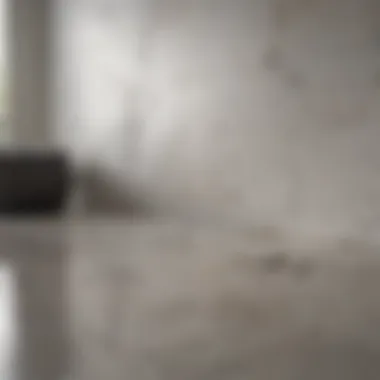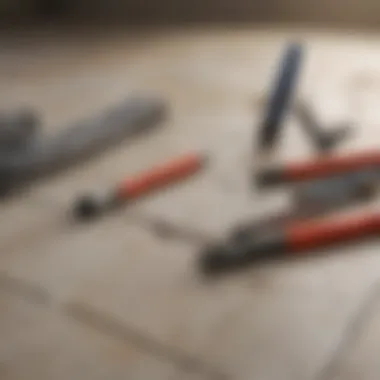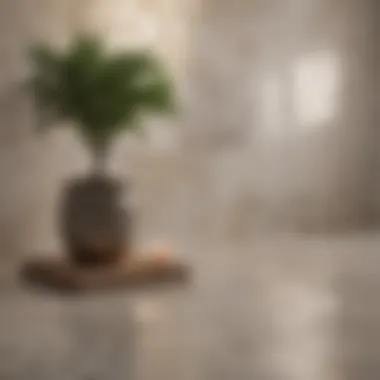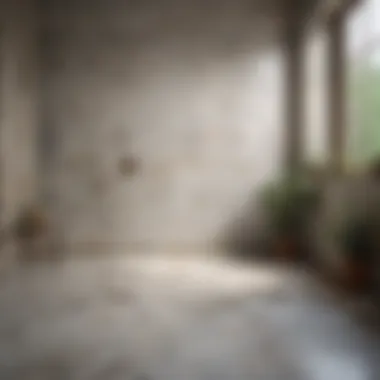Effective Methods to Conceal Cracks in Tiles


Intro
Cracks in tile installations can disrupt the aesthetic harmony of any room. These imperfections not only detract from the overall appeal but can also signal deeper issues with the flooring or wall structure. Understanding effective methods for concealing these cracks is essential for homeowners or anyone involved in interior design. This guide will illuminate several strategies for repairing and camouflaging cracks while highlighting preventive measures to minimize future occurrences.
By focusing on various tile types and use cases, readers will be able to identify the most suitable approaches for their specific needs. This exploration promises to equip homeowners and design enthusiasts alike with the knowledge to maintain and enhance their spaces effectively.
Key Insights and Trends
A close examination of current trends reveals an increasing emphasis on aesthetics and durability in interior design. With the rise of open floor plans and the desire for cohesive visual flow throughout living spaces, even minor imperfections like cracks assume substantial importance. As homeowners look for practical yet stylish solutions, the following insights are worth noting:
- Material Choices: There is a notable shift toward high-performance tiles. Porcelain and ceramic tiles are favored for their resilience, whereas natural stones like marble and granite offer elegance but require more maintenance.
- Design Cohesion: Cracks can disrupt the visual flow of a room. Many homeowners now seek designs that seamlessly integrate tiles with other materials, such as wood or laminate, to minimize visual distractions.
"The selection of tile should not only take aesthetics into account but also functionality, as this can prevent long-term issues like cracking."
Practical Tips and How-To Guides
For those encountering cracking, the right approach is essential. Here are some practical tips to address tile cracks effectively:
- Temporary Solutions: These methods can be quick fixes.
- Permanent Repairs: When deeper cracks emerge, consider these more involved methods.
- Tile Paint: Use tile paint to color over hairline cracks, making them less noticeable. This solution is fast and cost-effective.
- Grout Touch-Up: For cracks near grout lines, a quick touch-up with a matching grout can help blend imperfections.
- Epoxy Fillers: For wider cracks, epoxy can serve as a strong adhesive while providing additional color matching options.
- Tile Replacement: In severe cases, replacing damaged tiles may be necessary. Ensure you have extra tiles from the original installation for a perfect match.
In addition to these strategies, it's essential to adopt preventative measures to avert future cracking, such as regular maintenance checks and climate control adjustments that ensure consistent temperature and humidity levels in your home.
Prelims to Tile Cracks
Cracked tiles can be more than just an eyesore; they can undermine the entire aesthetic of a room. Understanding the dynamics of tile cracks is crucial for homeowners and design enthusiasts. This article aims to detail strategies for concealing these imperfections effectively, promoting both visual appeal and functional integrity.
Addressing cracks not only enhances the overall design of your living space but also maintains the longevity of your tiles. Moreover, identifying the causes and types of cracks provides a foundation for preventing future damage.
In this section, we will explore the two significant areas of concern: the different types of tiles and their specific vulnerabilities, as well as the common causes for tile cracks. Knowing these aspects deepens the understanding of the issues at hand and sets the stage for exploring various concealment strategies.
Understanding Different Types of Tiles
Tiles are not a one-size-fits-all solution. Each type serves unique purposes and has different characteristics. Common tile types include
- Ceramic Tiles: Known for their affordability and versatility, ceramic tiles are popular in many households. They are easy to maintain but can be prone to cracks under heavy impacts.
- Porcelain Tiles: Denser and less porous than ceramic, porcelain tiles are more durable and moisture-resistant. However, they require professional installation due to their hardness.
- Natural Stone Tiles: This includes granite, marble, and slate. They offer a unique aesthetic but can be more susceptible to cracking if not properly sealed and maintained.
By recognizing the distinct features of various tile types, homeowners can make informed decisions on repair strategies that suit their specific needs.
Causes of Cracks in Tiles
Several factors lead to cracks in tiles, and understanding these can aid in prevention and effective concealment. The primary causes include:
- Poor Installation: If tiles are laid improperly or the adhesive is inadequate, the likelihood of cracks increases.
- Temperature Fluctuations: Extreme changes in temperature can cause materials to expand and contract, leading to cracks.
- Moisture Damage: Water infiltrating the substrate can weaken the tiles and cause them to crack.
- Heavy Loads: Excessive weight on tiles can lead to fissures, especially in areas like kitchens and bathrooms.


By analyzing these causes, homeowners can implement targeted preventive measures, ensuring both immediate and long-term solutions. Understanding the genesis of tile cracks empowers individuals to maintain the aesthetic charm of their spaces while addressing the practical implications of these flaws.
Assessing the Damage
Assessing the damage is a crucial step in dealing with cracks in tiles. Understanding the extent and type of cracks present helps in deciding the most effective course of action. Proper assessment ensures that repairs not only conceal the cracks but also restore the structural integrity of the tile installation. Skipping this step may result in temporary fixes that could lead to more serious issues down the line.
When looking at tiles, observe their surface carefully. Some cracks are superficial, affecting only the glaze. These may not compromise the functionality but can detract from the visual appeal. Other cracks may run deeper, potentially leading to water infiltration or loosening of the tile. Therefore, assessing these cracks accurately allows homeowners to prioritize repairs based on severity and urgency.
Identifying the Severity of Cracks
When identifying the severity of cracks, categorize them into three main levels: minor, moderate, and severe. Minor cracks are small and shallow, often just a few inches long. They do not pose a structural threat and can be easily concealed with a tile sticker or caulk. Moderate cracks are deeper and may extend across the tile surface. These require more attention, such as grouting or applying epoxy filler. Finally, severe cracks extend beyond a single tile, possibly affecting surrounding tiles or the substrate. These situations often necessitate complete replacement or a professional intervention.
"Timely evaluation and proper response can save homeowners many troubles later."
To assess the severity:
- Look for length, width, and depth. Measure the cracks to document their measurements.
- Check the surrounding tiles for signs of shifting or looseness. This often indicates broader issues that must be addressed.
- Pay attention to water damage signs such as discoloration or mold, which can indicate more significant problems.
Determining the Type of Repair Needed
Once the severity is evaluated, the next step is determining the type of repair needed. Different cracks demand distinct approaches. For minor cracks, simply filling in the gap with caulk or a tile sticker might suffice. These solutions are quick, affordable, and effective in maintaining the aesthetics of your tiles.
In cases of moderate cracks, consider using an epoxy filler. This material adheres well to the existing tile and can enhance durability. Apply it carefully, ensuring the filler merges with the tile’s surface for a seamless look.
Severe cracks may require more extensive action. In such instances, replacement of the cracked tiles is often the best option. It not only resolves the immediate issue but also prevents further complications. Keeping spare tiles from the original installation can be beneficial for achieving a cohesive appearance.
Selecting the appropriate repair method ensures that the tiles not only look good but also function well in the long term. A well-assessed damage situation leads to thoughtful and strategic repairs, ultimately preserving the integrity and beauty of the tiles.
Temporary Solutions for Concealing Cracks
Temporary solutions for concealing cracks in tiles provide immediate relief when aesthetic issues arise. Homeowners often need quick fixes that do not require extensive work or financial investment. These methods allow for visible improvements while delaying more involved repairs. The charm of temporary solutions lies in their accessibility and ease of implementation, making them suitable for a variety of projects, from functional bathrooms to elegant living spaces.
Using Tile Stickers
Tile stickers, also known as tile decals, offer a practical way to mask cracks. These easy-to-use adhesives come in numerous designs, colors, and textures, allowing homeowners to choose a sticker that blends with the existing tile or contributes a fresh flair. Application is straightforward; one simply peels off the paper backing and places the sticker over the crack, pressing firmly to ensure adherence.
"Tile stickers provide an instant transformation, often revitalizing spaces with minimal effort."
Keep in mind that while effective for cosmetic enhancement, these stickers are not waterproof. They perform best in dry areas, like living rooms or bedrooms, rather than in moisture-prone spaces such as bathrooms or kitchens. Regular cleaning may also affect their longevity. Thus, selecting high-quality stickers and confirming compatibility based on tile location is crucial. This solution is ideal for those who appreciate style but require a quick fix with minimal investment.
Applying Caulk for Quick Fixes
For a more durable temporary fix, applying caulk can be effective. This silicone-based product fills gaps and seams, providing a streamlined appearance that helps blend cracks into the tile's existing texture. It is particularly useful for smaller cracks and can be painted to match the surrounding area if desired.
The process includes cleaning the crack area thoroughly to ensure proper adhesion. Once clean, a steady application of caulk into the crack will suffice. After applying, smoothing the surface with a wet finger can create a clean finish. Let it cure as per manufacturer’s guidelines to achieve effective results.
Some considerations when using caulk include:


- Flexibility: Ensure to choose a flexible caulk to accommodate slight movements in the tiling.
- Color Matching: Select a pigment that matches the existing tile or is suitable for painting over.
- Durability: Opt for a product rated for long-lasting use, especially in high-traffic areas.
For quick fixes, caulk can be an excellent choice that balances effectiveness with ease of application. However, being a temporary solution, it should lead to more permanent efforts in the future.
In summary, employing temporary solutions such as tile stickers and caulk play a vital role in maintaining the visual appeal of tiled surfaces while waiting for more permanent repairs. These solutions require minimal effort and resources but can significantly enhance an environment. They are crucial for quick aesthetic fixes without undertaking major projects.
Permanent Repair Techniques
In the context of tile maintenance, the significance of permanent repair techniques cannot be understated. Unlike temporary solutions, which may only address the visual aspect of cracks, permanent methods restore the integrity and durability of the tiled surface. Implementing these strategies not only enhances the aesthetic appearance of your tiles but also prolongs their lifespan, reducing the need for more extensive repairs in the future. Homeowners who understand and utilize permanent repair techniques are better equipped to safeguard their investments in flooring and wall finishes.
Epoxy Filler Application
Epoxy fillers offer a formidable solution for repairing cracks in tiles. They come in two parts: a resin and a hardener, which when mixed, create a robust adhesive that bonds well with most tile surfaces. Applying epoxy filler is a straightforward process. Begin by cleaning the cracked area thoroughly. This ensures that no dirt or residue interferes with adhesion. Once clean, prepare the epoxy according to the manufacturer's instructions. After mixing, apply it directly into the crack using a small tool, such as a putty knife. Make sure to overfill slightly to allow for sanding later, which will result in a smooth finish. After the epoxy has cured, sand down any excess to ensure that it is level with the surrounding tile. This method is effective because it not only fills the crack but also strengthens the tiles, making them less susceptible to future damage.
Grouting Cracks
Grout is another effective method for addressing cracks, particularly in spaces with ceramic or porcelain tiles. Unlike epoxy fillers, grouting is more suitable for smaller fissures. Start by removing any loose material from the crack and cleaning the area around it. This step is crucial for ensuring a strong bond. Choose a grout color that matches your tiles for a seamless appearance. Using a grout float, press the grout into the crack, working from the deeper sections outward. This technique allows for proper packing, minimizing air pockets. Once applied, wipe away any excess grout with a damp sponge and allow it to fully cure as per the instructions. When done correctly, grouting can significantly enhance the appearance of your tiles while offering a degree of protection against moisture and dirt infiltration.
Replacement of Cracked Tiles
In cases where a tile is severely cracked or damaged beyond repair, replacement may be the most effective solution. This process is slightly more complex and requires careful attention to detail to ensure proper alignment with surrounding tiles. Begin by carefully removing the cracked tile using a chisel or utility knife to break the bond with the adhesive. Once the tile is removed, clean the subfloor or wall surface to eliminate any residue. Measure and cut the new tile to fit the space, if necessary. Apply a suitable adhesive to the back of the new tile, and position it precisely in the opening, ensuring it is level with adjacent tiles. Once set, re-grout the edges to match the existing grout lines. Replacing a cracked tile might seem labor-intensive, but it ultimately restores the surface's continuity and function, providing a fresh look to your space.
In summary, permanent repair techniques such as epoxy filler application, grouting, and tile replacement effectively address tile cracks, ensuring both functionality and aesthetics are preserved.
These methods are essential for homeowners looking to maintain their tiled surfaces in optimal condition.
Special Considerations for Different Tile Types
When dealing with tile cracks, understanding the specifics related to different tile materials is essential. Each type of tile has unique characteristics that affect how cracks form and how they can be concealed or repaired. This section will delve into ceramic, porcelain, and natural stone tiles, emphasizing their differences and the implications for repair strategies.
Ceramic Tiles
Ceramic tiles are among the most commonly used flooring and wall coverings. They are made from clay and other naturally occurring materials, which are fired at high temperatures. While they offer a good balance of durability and affordability, ceramic tiles are still vulnerable to cracking due to impacts or extreme temperature changes.
When concealing cracks in ceramic tiles, the approach often involves both aesthetic and practical solutions. Using epoxy fillers is a common method that can fill in seams and imperfections, helping to restore the surface’s visual appeal. Additionally, applying a layer of matching grout over the crack can enhance the overall appearance. Keep in mind that color-matching is critical in this process, as mismatched colors can distract more than the crack itself.
Porcelain Tiles
Porcelain tiles are a step above ceramic in terms of density and durability, made from a finer type of clay and fired at even higher temperatures. This increased strength makes porcelain less prone to cracking under typical household conditions. However, when cracks do appear, they can be more challenging to fix due to the tile's dense nature.
For porcelain, it is advisable to approach repairs with specialized porcelain tile fillers that are designed specifically for this material. These fillers can bond better and withstand moisture better than regular options. Moreover, for aesthetic repairs, consider using color-matched touch-up kits that blend seamlessly with the surrounding tile. Such precision is crucial, as porcelain is often used in high-traffic areas where any blemishes could be more noticeable.
Natural Stone Tiles
Natural stone tiles, such as granite or marble, offer unique beauty and are usually quite durable. However, their natural composition can make them susceptible to cracking, particularly in humid environments where expansion and contraction occur. Additionally, the weight of the stone can also lead to cracking if not installed correctly.
When repairing cracks in natural stone, the strategy shifts toward maintaining both durability and aesthetics. Stone epoxy can be applied to fill large cracks, while smaller fissures may benefit from a sterile injection method to ensure a strong bond. Furthermore, using sealer post-repair helps prevent moisture ingress and prolongs the life of the repair. To enhance the look, it’s often useful to buff the area after the epoxy sets to match the original sheen of the stone.


It is essential to choose the right product for each tile type to ensure effective repairs and maintain the tiles' integrity and appearance.
The type of tile significantly dictates the approach to cracking repair—understanding these distinctions allows for more effective strategies to not only conceal cracks but also enhance the longevity of the tiles.
Preventive Measures to Avoid Cracks
Preventive measures are critical in minimizing the chances of tile cracks appearing in the first place. Recognizing the importance of proactively addressing potential issues can save homeowners from the disappointment and frustration of cracked tiles. By following effective strategies, you can ensure the longevity of your tile installations and maintain their aesthetic appeal. Good preventive practices not only protect against damages but also promote a more stable environment for the tiles, ultimately leading to less maintenance and repair costs.
Proper Installation Techniques
Proper installation techniques play a significant role in preventing cracks in tiles. When tiles are installed without adequate preparation, the likelihood of cracks increases drastically. It is essential to follow best practices such as:
- Surface Preparation: Ensure the subfloor is clean, dry, and level before installation. Any imperfections can transfer to the tiles, causing cracks under pressure.
- Quality Adhesives: Choose high-quality tile adhesive that suits the specific tile type. Substandard adhesive may not bond the tiles securely.
- Grout Application: Proper application of grout can help absorb movements that cause cracks. Make sure that the grout is applied evenly without gaps that can lead to stress.
By focusing on these aspects, you can greatly reduce the possibility of cracks developing from installation errors.
Maintaining an Appropriate Temperature
Temperature fluctuations can lead to expansion and contraction of the tiles, which is a common cause of cracks. It is important to maintain a relatively stable temperature in areas where tiles are laid. Here are some recommendations:
- Avoid Direct Sunlight: If tiles are in high sunlight areas, consider using window coverings or awnings to shield them from extreme heat.
- Temperature Regulation: Use heating systems efficiently, keeping in mind that rapid changes in temperature can cause stress on tiles.
- Monitor Humidity Levels: High humidity can impact the integrity of some tiles, leading to possible damages. Use dehumidifiers to maintain adequate moisture levels in indoor environments.
Staying vigilant about temperature will go a long way in preserving the condition of your tiles.
Using Flexible Grout
Flexible grout is an essential consideration for preventing cracks. Unlike traditional grout, flexible grout can withstand minor movements in tile installation without cracking. Utilizing flexible grout can provide significant benefits:
- Enhanced Flexibility: It can adapt to minor shifts in the flooring, which can occur due to weight or thermal expansion.
- Reduced Risk of Cracking: The composition of flexible grout allows it to absorb stress, preventing cracks from developing in both the grout lines and adjacent tiles.
- Longer Lasting Repair: Using flexible grout means fewer maintenance issues over time, as it can last longer than regular grout, thus preventing the need for frequent repairs.
In summary, selecting the right materials and techniques during installation and environmental controls plays a substantial role in ensuring tiles remain free of cracks. With preventive measures in place, homeowners can enjoy their tiled spaces without the worry of unsightly damages.
Culmination
The conclusion is a crucial section in any discourse regarding tile maintenance. In this article, it compiles the essential themes discussed in previous sections, shedding light on the multifaceted strategies to not only conceal cracks but also maintain the overall integrity and aesthetics of tiled spaces. Highlighting the value of each method provides readers with a clearer understanding of which repairs or preventive measures best suit their specific needs.
Evaluating the Effectiveness of Repair Methods
Evaluating repair methods is necessary for ensuring long-term solutions. Different techniques, such as the application of epoxy fillers, grouting, or even tile replacement, have varying levels of success depending on the nature and extent of damage. Homeowners need to assess the effectiveness of each repair implemented. Some methods might provide swift concealment of the cracks but could offer limited durability. Others might involve more time and resources but lead to lasting results.
To properly evaluate repair effectiveness, consider these aspects:
- Longevity: How long will the repair last under normal wear and tear?
- Aesthetic Appeal: Does the method effectively blend with surrounding materials?
- Cost: Are the materials and time invested proportionate to the outcome?
- Ease of Application: Can it be performed without professional help?
Taking time to review these elements ensures that your tile surfaces not only look presentable but stand the test of time.
Encouraging Regular Maintenance
Regular maintenance is integral to avoiding cracks and other tile issues down the line. Homeowners should adopt a routine that involves periodic inspections. Identifying wear or damage early allows for timely intervention, which can prevent small issues from escalating into larger, costlier repairs.
A few key practices for regular maintenance include:
- Routine Cleaning: Keep tiles free from dust and debris. Dirty tiles may show superficial cracks that grow over time.
- Sealant Application: Using sealants on natural stone tiles can greatly increase their durability and resistance to moisture.
- Temperature Control: Maintaining a stable indoor temperature helps prevent the expansion and contraction of tiles, reducing potential cracking.



